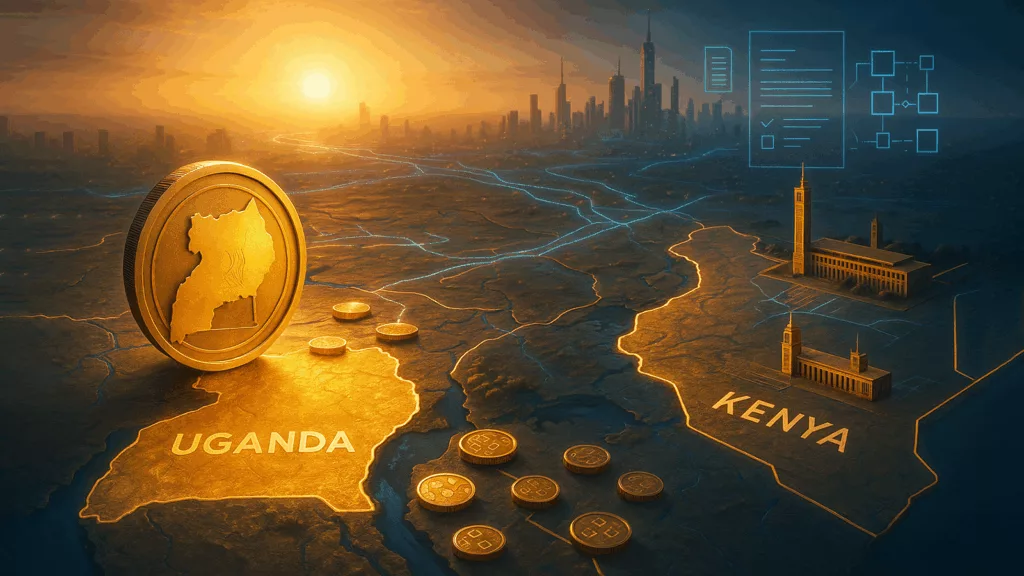- Uganda launched a $5.5 billion tokenization and CBDC pilot to digitize national infrastructure assets and advance financial inclusion.
- Kenya progressed its Virtual Asset Service Providers (VASP) Bill, signaling growing regulatory alignment across East Africa.
- Sub-Saharan Africa recorded $205 billion in on-chain transactions, cementing its status as a global crypto adoption leader.
Uganda has rolled out one of Africa’s most ambitious blockchain programs a $5.5 billion real-world asset tokenization initiative paired with its first central bank digital currency (CBDC) pilot, marking a major leap in the region’s digital transformation.
The project, launched in collaboration with the Global Settlement Network (GSN) and Diacente Group, aims to bring physical infrastructure assets including food production, mining, renewable energy, and trade onto the blockchain. The initiative also introduces the digital shilling, a CBDC backed by Ugandan treasury bonds and built on GSN’s permissioned blockchain framework.
The digital shilling will adhere to KYC and AML compliance standards, ensuring secure and regulated transactions. It will also be accessible via smartphones and USSD technology, enabling over 40 million Ugandans to engage in digital payments for the first time.
Newsletter
Get weekly updates on the newest crypto stories, case studies and tips right in your mailbox.
The rollout supports Uganda’s Vision 2040 and the African Union’s Agenda 2063, with the Karamoja Green Industrial and Special Economic Zone (GISEZ) serving as the project’s centerpiece. Expected outcomes include the creation of over one million jobs and potential annual exports surpassing $10 billion.
Diacente Group Chairman Edgar Agaba emphasized that the project “goes beyond infrastructure, adding that integrating tokenization and CBDCs into Uganda’s roadmap would “attract new capital, empower industries, and drive sustainable growth.
Kenya Advances Regulatory Framework With VASP Bill
While Uganda pursues blockchain-powered development, neighboring Kenya is advancing the Virtual Asset Service Providers (VASP) Bill (N.A. Bill No. 15 of 2025), now in its third reading before parliament.
The legislation grants oversight to the Central Bank of Kenya (CBK) and the Capital Markets Authority (CMA), aiming to regulate digital assets, combat financial crimes, and encourage innovation in the sector.
The bill is essential for “protecting Kenya’s monetary system while promoting responsible innovation. Once enacted, the Treasury will have the authority to create specific rules on stablecoins, tokenization, exchanges, ICOs, and cybersecurity.
The Virtual Asset Consortium of Kenya (VACC) noted that this legislation would position Kenya among Africa’s top five crypto-regulated nations, strengthening investor confidence and regional digital infrastructure.
Sub-Saharan Africa Leads Global Crypto Growth
According to Chainalysis, Sub-Saharan Africa remains a powerhouse of digital asset adoption, recording $205 billion in on-chain transactions between July 2024 and June 2025 the third-highest global growth rate.
Nigeria continues to lead the continent after launching its CBDC in 2021, followed by Ghana and South Africa with completed pilots. Egypt, Kenya, and Rwanda are still in the consultation stage, while Statista projects that Africa’s crypto user base will exceed 75 million by 2026, generating an estimated $5.1 billion in revenue.
Stablecoins now account for 43% of Sub-Saharan Africa’s crypto transaction volume, primarily driven by Nigeria, South Africa, Ghana, Kenya, and Zambia. Partnerships such as Ripple’s RLUSD expansion and Visa’s collaboration with Yellow Card are fueling new applications in remittances, treasury operations, and climate insurance.
Despite the rapid progress, more than 80% of intra-African payments still depend on foreign banking infrastructure, highlighting a persistent gap that blockchain and CBDC projects aim to fill.
As Uganda’s tokenization efforts and Kenya’s regulatory strides converge, East Africa is positioning itself at the forefront of a regulated, inclusive, and blockchain-powered financial future.













